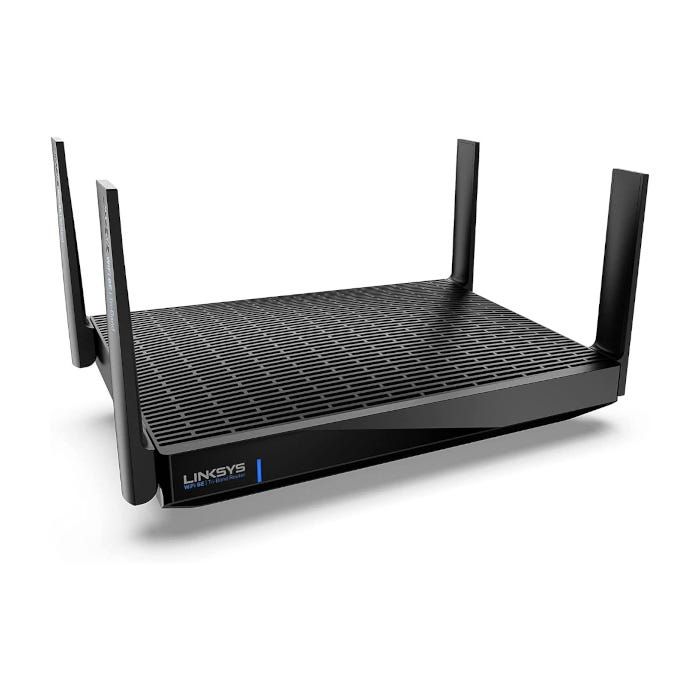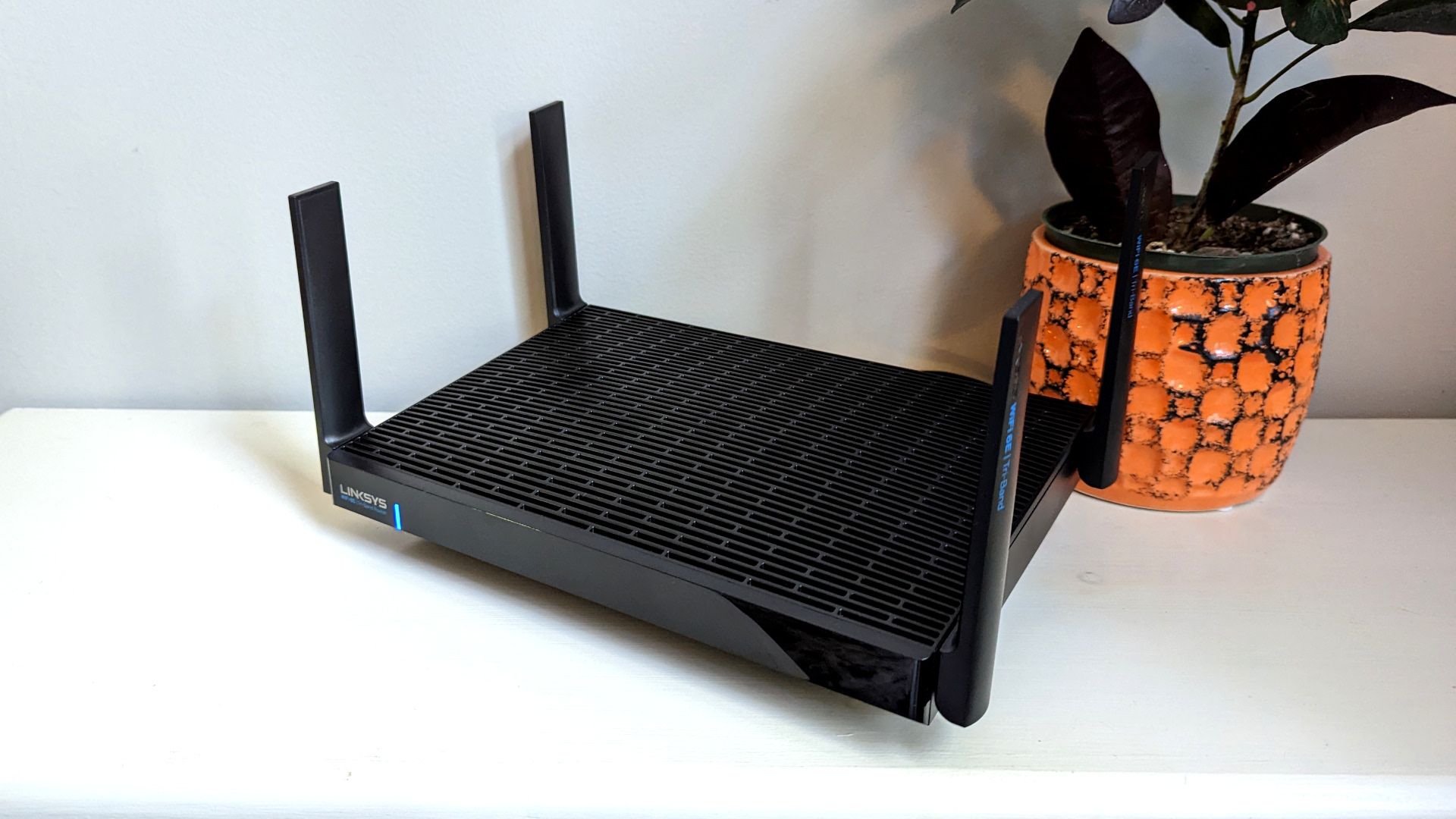Quick Links

If you've shopped for a router lately, you've probably noticed Wi-Fi 6E options getting more and more common. Linksys added to that pool with the Hydra Pro 6E, a tri-band mesh router promising multigigabit speeds at an attractive price.
In our roundup of the best Wi-Fi 6E routers, we awarded the Hydra Pro 6E the best budget option, and it lives up to that label in several ways. Without too much strain on your wallet, it better futureproofs against the coming multi-gigabit world than some other 6E offerings out there. You can connect other nodes to create a mesh network, but even as a standalone router, it offers substantial coverage. That said, competing standalone routers offer more Ethernet ports, and you also might be put off by the very exposed ventilation and restrictive setup procedure.
Hardware: Naked and Afraid
- 4 x 180-degree rotating antennas
- 1 x 5-gig WAN port
- 4 x 1-gig Ethernet port
- 1 x USB 3.0 port
The very first thing that struck me when unboxing this router was the sheer amount of ventilation it has. Large vents on the top, vents on the sides, vents on the bottom---so many vents. In fact, it made me a little uncomfortable. Nowhere on the packaging or store listing did I see Linksys making this visible, but if you look straight down at the Hydra Pro's topside, you can see clear through to much of the internals.
Though I didn't tear the router apart for inspection (you almost don't have to), I couldn't see or hear a fan. Evidently, the router relies on these vents as part of a completely passive cooling system.
There's nothing inherently wrong with such ample ventilation. You just need to avoid covering the router at all and be sure to place the device somewhere safe from spills or any other falling debris. That's easy enough, but it still made me uncomfortable, remembering the time a water heater in the apartment above me sprung a leak. You can imagine the result, which wasn't good for most electronics, but I can only imagine how much more susceptible this router would have been.
Port-wise, the Hyrda Pro 6E is on the humble side, offering four Ethernet connections that are limited to 1Gbps each. Competing standalone 6E routers normally offer at least one more port, and possibly the ability to aggregate ports. As a mesh router, though, it's forgivable since I could virtually add more ports by connecting additional mesh nodes that have their own ports.
But while the Ethernet ports might not be worth writing home about, the 5-gig WAN port is definitely worth your attention. That's twice the size of the best WAN port on any of our other favorite 6E routers, including the more expensive options. It's an important boost to futureproofing because, though your fastest speed options may only be 1 or 2 gigs at the moment, Google is already testing 20-gig fiber connections. You don't want to get caught down the road paying for internet speeds your router can't fully put to work.
Setup: Easy, But App Required
You can set up the Hydra Pro 6E with minimal hassle using the Linksys mobile app for Android or iPhone. You should be aware though that, at least as far as I could tell, the app isn't optional.
The last router I reviewed, the Netgear Nighthawk RAXE300, gave me the option to set it up manually instead of using the app. The Netgear mobile app would also let me bypass account registration during setup by disconnecting from Wi-Fi and data. None of that was possible with the Hydra Pro 6E. Even when I tried connecting a PC via wire and accessing the router login page, I still only got a splash page directing me to install the mobile app. I found this annoying and a bit restrictive.
Once I got over it, though, I found the setup process was very straightforward. Plug in the device and follow the prompts on your phone. Even after the setup, though, whenever I'd open the router login page on my PC, I would have to click through the same splash page encouraging me to use the mobile app instead. Linksys really wants you to use the app. In its defense, the app does cover all the settings you'll likely use.
The Hydra Pro 6E can wear three different hats, in a sense: it can be a standalone router, a mesh parent node, or a mesh child node. I didn't have any additional mesh nodes compatible with the Hydra Pro 6E, but from the rest of my experience with the app, I'd expect it to be a quick setup as well.
I should note when at least when I first started using the Hydra Pro 6E, I'd sometimes get devices not using the best wireless band possible. The router assigns bands automatically by default, and for a while, it was insisting my 5Ghz-capable PC located in the same room as the router stay on the 2.4Ghz band. The problem eventually worked itself out, though, and I didn't see it happen again.
Performance: Solid Speeds Leaning Into the Future
- Maximum Wired Speed: 1Gbps
- Maximum 2.5Ghz Speed: 600Mbps
- Maximum 5Ghz Band Speed: 1.2Gbps
- Maximum 6Ghz Band Speed: 4.8Gbps
I generally had a great experience speed-wise using the Hydra Pro 6E with my 1-gig fiber connection. I tried stressing the system by streaming 4K movies, downloading a large Google Drive file, and playing an online FPS game at the same time, all wirelessly and on the same band. I couldn't get any significant drop in performance from that routine.
That said, if you look at the maximum speeds, you'll notice the 2.5Ghz and 5Ghz are significantly lower than the 6Ghz band. From one perspective, it makes sense: 6Ghz is a faster band, and in the future, more demanding devices will need that speed.
At the moment, though, 6E-ready devices that can connect to the third band are rare and premium. Our Google Pixel 6 and 6a were 6Ghz-capable, but you should be aware that even the iPhone 14 is still stuck at Wi-Fi 6. That means, for now, most of your wireless devices will only be able to use those first two bands. If you have too many competing for those smaller bandwidth portions, you can potentially run into slowdowns.
That problem of course is due to shrink with time. Long-term, it's a good thing the Hydra Pro 6E reserves most of its speed for 6Ghz. You do have to bear in mind that 6Ghz is always going to have the weakest signal, but you can potentially remedy that problem as needed by connecting additional nodes.
Coverage: Going the Distance
- Maximum Range: 2,700 square feet
- Maximum Number of Connected Devices: 55+
- Processor: 1.8GHz Quad Core
- 4x4 MU-MIMO
The Hydra Pro 6E hits aims for the bullseye with total coverage hitting a bit more than the average home size in the US. My home is around 1,400-square-feet, so it's well within the router's promised coverage.
One of my critiques of the Nighthawk RAXE300 was that the 6Ghz signal, the main attraction of going Wi-Fi 6E, didn't quite cover my entire house. It's a slightly more expensive router than the Hydra Pro 6E, so I worried I'd face even more 6Ghz dead zones this time. But I was pleasantly surprised to find that frequency reaching every inch of my home.
In fact, I had to take my phone all the way to the back of my good-sized backyard before I lost connection with the 6Ghz band, which is far more than I could say for the RAXE300. The 2.4Ghz and 5Ghz bands naturally took the baton at this point, despite interference from neighbors on either side of me.
Should You Buy the Linksys Hydra Pro 6E?
My recommendation in part depends on how you plan to use the Hydra Pro 6E. Do you just need a standalone router and take your time upgrading phones, laptops, and other wireless devices? Something similarly priced like the RAXE300, or a Wi-Fi 6 router like the ASUS RT-AX88U, will get you faster speeds on the 2.4Ghz and 5Ghz bands you'll probably use the most right now.
However, if you have average needs for wired connections and also don't have an outsize number of wireless devices that will crowd out those more limited lower bands, the Hydra Pro 6E is an excellent choice for futureproofing your internet setup. Even if the Ethernet ports and signal range don't meet your needs, those can be reliably extended with additional mesh nodes.
Just make don't set any uncovered drinks next to it, lest you tragically hydrate your Hydra.

Linksys Hydra Pro 6E
- Fantastic WAN speeds
- Generous tri-band coverage
- Easily expanded with more mesh nodes
- Speeds reserved mostly for the 6Ghz band
- Mobile app required for setup
- Oddly open-air design

